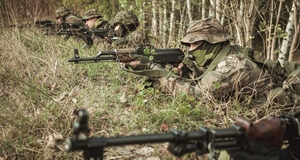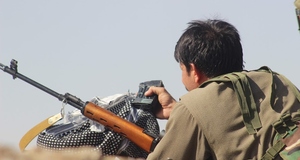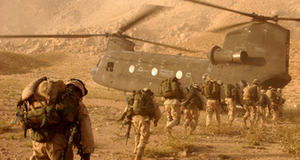From Clocks and Clouds VOL. 7 NO. 1Reevaluating Military Strategy: The Effectiveness Of Conventional Deterrence
IN THIS ARTICLE
KEYWORDS
AbstractThe rise of modernized and efficient militaries competing for dominance against the United States' military has resulted in increased eruptions of conflict globally. A majority of decisions by the Joint Chiefs and EUCOM about long-term U.S. military policy in these areas are currently being based off personal and historical observations, along with blatant speculation. The question that should be asked before formulating these positions is if crisis management techniques, like conventional force movement, have a positive effect on the response to crisis triggers. The aim of this research is to understand the effectiveness of forward deployed forces to conventionally deter adversaries and reduce or stop conflict. A majority of previous deterrence researchers have focused on the change in utility during a crisis between actors to determine if deterrence was successful. However, there is still a lack of research on whether force variables have had an effect on conflict dynamics during non-conflict years. The answer for this research will be found by testing the level of hazard for conflict using cox regression based on U.S. troop levels and position during the time difference between conflicts in singular countries. Based on initial inquiry and extensive background research, this research hypothesizes that forward deployed troops will have either no effect or a worsening effect. The results from this research should provide greater insight into future military policies toward conflict situations and whether troop deployment is the effective. The past five years has seen an upsurge in organized violence and conflicts, contradictory to the overall trend of the past fifty years. These conflict escalations are occurring across the globe with higher and higher frequency, particularly in Eastern Europe. Such instances include an increase in unannounced Russian military exercises, the invasion of Ukraine by proRussian separatists, and the rising threat of nuclear engagement after Russia's boycott of the 2016 Nuclear Security Summit. To a lesser but important extent, this also includes the aggressive island-building in the North China Sea. It is pre-supposed that the deployment of the United States Army to these regions would reduce the outbreak of violence, because its mission has been to deter as well as reassure its Allies since WWII. As Deputy Secretary of Defense Bob Work recently remarked on the Third U.S. Offset Strategy for the Army, "our ability to project dominant military forces across the trans-oceanic distances underwrites U.S. conventional deterrence" (Department of the Army 1985). These dominant military forces take the form of forward deployed forces within the European and East Asian theaters, and in the Middle East with Operation Spartan Shield. Just recently, within President Obama's Fiscal 2017 summary, it mentions "deterrence" three separate times in concern with Chinese and Russian aggression, and an increase in funding for the European Reassurance Initiative (ERI) (Office of the University of Defense 2016).However, there is a lack of evidence to suggest that these deterrence strategies against Russia and China are successful (French 2014). In recent months, the United States has sent naval forces into the North China Sea to "reiterate" international maritime movement to the Chinese. Likewise, the US government announced an increase in military bases, weapons, and forward deployed forces along the Eastern European frontier in NATO countries (Estonia, Latvia, and Lithuania). This comes on the heels of Russia's second invasion of Ukraine and growing attempts of coercion against the three Baltic Republics, all of which have sizable ethnic Russian populations. Yet, in both cases of deterrence strategies, the exact opposite occurred. China released a statement vehemently condemning the actions of the United States and demanding that they stay out of China's zone of influence. Russia has also continued its own military build-up along its Western frontier. If the deployment of conventional forces does not deter these aggressions, significant questions emerge about the structure, size, and application of military power in the modern world. This research seeks to estimate the extent to which forward deployed conventional forces deter conflict. This inquiry sits within a broader body of scholarship that struggles to accurately disseminate what is causing determent (Harvey 1999; Huntington 1984; Huth 1988; Ladwig III 2015; Mearsheimer 1983; Smith 2004; Wilner 2015). Previous military policy scholars have focused on the change in utility throughout the progression of a crisis between actors to determine the success of deterrence. In other words, they focused on the push and pull of cost-benefit strategies between the various actors. Yet, there is still a lack of sufficient analysis on whether military forces have had a positive effect on conflict de-escalation between conflict events. Thus the question emerges: do forward deployed troops actually deter conflict situations? Based on recent research on deterrence strategies, scholars are beginning to question the overall effectiveness of the U.S. military's current strategy of deterrence. If empirical analysis shows that forward deployed forces do not deter, this raises significant questions about the U.S.'s military posture and spending. If forward deployed forces actually escalate conflict situations, their entire logic of conventional deterrence is misguided and dangerous. If forward deployed forces have no effect on crises, then the entire conventional deterrent posture is suboptimal. The United States is either engaging in dangerous policy or bad policy. In this research, I focus directly on these forward deployed troops in conflict zones and, contrary to current scholarly trends, argue that conventional forces still have an effective, de-escalating effect in crises. The results of this analysis should be utilized to reassess future military postures toward conflicts and whether forward troop deployment is effective. Theoretical FrameworkIn contemporary research on conflict aversion, the realist paradigm has been the foundational theory of rationalization. Based on the logic of John Mearsheimer, Niall Ferguson, and Hans Morgenthau, interest defined as power and the security of the state constitutes the reoccurring actions and reactions of state movements and patterns (Ferguson 2003; Mearsheimer 1983; Morgenthau 1978). The emphasis and supremacy of state interest, and the necessity of state intervention when their interests are threatened was at the core of all actions. This threat of intervention has been the standard method used by states to manipulate their adversary's prudence toward their potential act. Scholars have since studied this practice as deterrence theory, and seek to further understand the benefits and consequences of using conventional deterrence. The argument at the center of this theoretical debate is whether conventional deterrence is applicable and effective in both the pre and postCold War world. Understanding the sheer complexity of conventional deterrence is challenging based on the number of factors simultaneously affecting a conflict. Almost every variable that influences the success or failure of deterrence is interconnected and dependent on each other to the point that a majority of scholarly research on the topic has a shared theme. For the sake of clarity and consistency, this paper will define conventional deterrence as "the direct or indirect persuading of an adversary, through threat of military retaliation, that the costs of their actions far out-weigh the benefits" (Huth 1988). Huth and Gelpi, as well as Wilner, describe cost and benefit analysis as both the challenger and the defender's threat and consideration of using military force (Huth and Gelpi 1993; Wilner 2015). This working definition will provide a more concise scope when analyzing the aspects of deterrence later in the research by specifically focusing on potential military action. Beyond understanding the theoretical framework of deterrence, scholars have further categorized the concept into two distinct practices with varying subparts; general and immediate deterrence, and central and extended deterrence (Smith 2004; Wilner 2015). General deterrence is seen as the anticipation of potential enemies in the future and the seeking of the rebalancing of power through coercion, whereas immediate deterrence is the more well-known practice of using threats of attack in order to prevent potential conflict escalation. Central deterrence is the classical sense of a bipolar world where superpowers seek to prevent attack on each other through a balance of powers system. This can be seen in conflicts in during the Cold War between the United States and the Soviet Union (e.g. Cuban Missile Crisis). Extended deterrence, on the other hand, involves the protecting of proxy allies from war through the use of threats, as well as a more "distance-iscomfort" protection strategy (e.g. Vietnam War) (Thränert 2015). During the Cold War, a majority of research on deterrence analyzed not only the success of conventional deterrence, but also the factors that determine how to conduct successful deterrence. This type of deterrence research is known as Classical Deterrence Theory. Classical scholars have since classified the success of conventional deterrence into four distinct variables: (A) a clearly defined behavior that is deemed unacceptable, (B) communication to the adversary a commitment to punish violations, (C) possessing the capability to defend this commitment, and (D) demonstrate resolve to carry out the retaliation if the adversary fails to comply (Huntington 1984; Zagare 1990). While they emphasize the importance of the capability of defenders to follow through on their commitment, almost all agree that the effectiveness of the psyche against the adversary is of the utmost importance. If these four conditions are satisfied, the expected net costs of the threatened sanction should be greater than the expected net benefits (Harvey 1999). In other words, much like a formula, the presence of these factors create successful results of deterrence strategies. Certain neo-classical deterrence scholars have since revisited this theoretical framework and have made further contributions. They argue that the absence of certain variables with the presence of others in this deterrence formula will worsen conflict situations (Ibid; Soloman 2013). An example pointed out by Frank Harvey is that the absence of resolve (D) is more likely to provoke noncompliance when defenders clearly communicate a threat of retaliation (A) along with a strong commitment to the issue (B) (Harvey 1999). The deterrence formula that was supposed to guarantee successful deterrence now may lead to further conflict escalation. Despite this finding, scholars continue to argue in favor of deterrence strategy and that the adoption of an action-retaliation tactic would work in favor of defending states. In the post-Cold War era, however, deterrence research has seen an increase in post-structural analysis that is now questioning the validity of many previous notions of deterrence theory. These new-era scholars argue that the world is no longer a bipolar structure, where escalation was linear between superpowers. Instead, they argue that the world is a multipolar structure that is interwoven in a web of four types of deterrence: conventional, strategic (nuclear), cyber, and space (Blackwell 2011; Payne 2001). Particularly, the new domains of cyber and space represent the growing awareness that conventional Land-Air-Sea forces and Nuclear/ICBMs are no longer sufficient. A good example of this is the Iran Nuclear Crisis, when Iranian nuclear facility networks were attacked by the online program Stuxnet, a computer worm used by foreign hackers in 2010 (Aronson 2009; Coleman 2012). Thus, postdeterrence theorists argue that electronic warfare, or "cyber-politque," is the preferred way to augment conventional threats and strikes in order to achieve campaign objectives (Soloman 2013). Unlike new technology and tactics, scholars are also beginning to analyze the effectiveness of unconventional methods of deterrence. Scholars have observed that this multipolar world generates such tactics for adversaries to "design around" a conventional deterrent once its outlines are evident (Ibid; Beattie 2010). For example, the use of geography by Pakistan, analyzed by Walter Ladwig III, is used to counter-deter the growing presence of a modernized military in India (Ladwig III 2015). The current argument emphasizes that the multipolar world of global communication and information sharing is eroding the power of conventional deterrence and traditional power simultaneously. Current conventional deterrence is at a cross road between two schools of thought: the realist/classical and the post-structural. The free flow of information and rapid communication has deteriorated the classical formula for deterrence success; however, the reoccurrence of military modernization and build-up across the world continues to keep the threat of force alive. Conventional deterrence has been around since the strategies of Thucydides, and it would certainly be unwise to abandon a policy of deterrence outright (Monten 2006). The aim of this research is to question the effectiveness and power of conventional deterrence strategies and provide adequate support for their continuation (Ferguson 2003). Analyzing the theoretical framework that scholars have produced vis-à-vis deterrence through extensive methodologies will better frame what is missing to accomplish this. Literature ReviewThe methodological approach most often used to research the effectiveness of deterrence has not changed much in the past 25 years. What has changed is how researchers define the success and failure of deterrence based on their chosen dependent variable. These variables have predominantly focused on statements and movements to acknowledge the deterrent action as success or failure; however, as Danilovic Vesna points out, it is near impossible to define true success and failure of deterrence by observing post-conflict actions. While this research is more focused on whether military forces have a deterring effect, it is essential to note that most research has been on analyzing variables post-conflict. This lack of a solid definition has created a lack of clarity on how to measure success and failure, resulting in case bias based on selection (Danilovic 2001). Huth and Russett's 1990 approach to testing deterrence attempts to set a standard for the measurement and testing of deterrence effectiveness. What sets their work apart from previous research is how they measured success and failure: as either the absence of force by the attacker, lack of defender concession, or a limited force fatality of at least 250. While the specificity of their definition allows for a more concise case selection to strengthen their research, the allowance of force absence as a factor created a subjective measurement. Lebow and Stein pointed out this subjective measurement when they conducted a cross-study of Huth and Russett's research, which resulted in differing successes and failures. They argued that in order to accurately define success and failure, deterrence research should focus more on contextdependent generalizations (Lebow and Stein 1990). Quackenbush tries to accommodate this in his own research through his quantitative analysis of general deterrence. Using a Militarized Interstate Dispute (MID) dataset by Ghosn, he measures success and failure by whether the attacker or defender concedes or if there is conflict (Ghosn 2004). He observes utility as the independent variable for each possible outcome in order to determine which action will result in successful deterrence, or game outcome. This was done by measuring it through Bueno de Mesquita and Lalman's equations for utility and simulating the variables in a multinomial logit (Quackenbush 2010). However, his research resulted in five separate outcomes from these equations, which calls into question the effectiveness of this methodology. Furthermore, Quackenbush's research also proves problematic for the accuracy of which outcome the players preferred, resulting in the inability to designate as success or failure of deterrence. The closest research to testing for variable effectiveness in deterrence is Frank Harvey's 1998 testing of hypotheses by previous researchers to prove the weakness of deterrence overall (Harvey 1998). The method he used was assigning each "overestimated" hypothesis a categorical weighted percentage, then calculating each for strength of deterrence. What is important to note is that Harvey's approach highlights the problems with using utility as a measurement of deterrence. However, his research still lacks sufficient empirical analysis of other possible variables that determine successful deterrence besides utility measurement. The overarching lack of clarity and variation in dependent variables within deterrence research, along with reliable case selection, is detrimental to accurately testing deterrence. What current testing on deterrence lacks most is an analysis of non-conflict times in order to observe if the same independent factors prevent a rise in crisis dynamic. This would provide a more contextual analysis of the changing dynamics pre and during the crisis based on the given factors. MethodologyThroughout this research, a large-n methodological approach was most appropriate in order to analyze the effect that U.S. troops positioned in conflict countries have over an extended period of time. It also proved to be effective in acquiring enough cases when using hazard model testing, like the cox proportional hazard model, which will be discussed later. The variables chosen for this specific research are tested for their effectiveness via the cox regression test, with US troop data as the covariant in assessing the hazard of a conflict occurring over a given time span. This research focuses on conflict occurrence as the dependent variable in order to observe influence during time change. In order to control for the variation in interpretation of what constitutes a crisis for case selection, this research will be using data from the International Crisis Behavior Version 10.0 (ICB10) (Brecher et al. 2016). The dataset contains 1000 crisis actors and 455 crises with a time span from 1950-2001. The chosen crises were selected based on the accumulation of three databases previously assembled by the researchers: dyadic crisis data, crisis-density rivalries, and one-sided crisis data (Brecher and Wilkenfeld 2010). In order to accommodate the time-dependent model necessary for this research, the dataset was altered to also include all non-conflicts years for every actor with at least one crisis. This will assist in providing a more accurate test for the level of hazard between crises. The analysis of U.S. troop force presence over the course of the time frame is integral to finding whether it has a direct, and hazardous, correlation to conflicts. As the independent variable, the level of impact that these forces have before, during, and after the selected crises should indicate whether they play a significant role on the overall hazard. In order to accommodate the data to fit the model test for this research, the data were transformed into five different subcategories: (0) 0 troops, (1) 1-50, (2) 51-100, (3) 101-500, (4) 501-1000, and (5) for 1000+. This categorization of the data will be more useful when inserting them into the model, as they can be compared in a repetitive fashion. Additionally, it provides greater clarity as to which cases have predominantly more troops because of alliances during conflicts (e.g. Germany has consistently had well over 1000+ since 1950, while India has relatively been between 51-100). The application of Cox Proportional Hazards Modeling (PH) is integral in assessing whether the presence of US troops in crisis zones has a positive or negative effect. Cox regression, as it stands, is a type of "survival analysis," or the length of time before the occurrence of the specified event happens (Smith, B. and Smith, T. 2000). The hazard function for cox regression describes the concept of risk as the outcome (e.g. failure, conflict eruption) in an interval after time t. The probability that the outcome occurs somewhere between t and t plus the change in time, divided by the probability the event doesn't occur beyond t. The hazard function h(t) is given by the following: What makes cox PH effective compared to non-proportional hazard tests, like Kaplan-Meier, is that the baseline hazard h0(t) does not entirely depend on X (the covariate), but also on t. Typically reserved for research analyses of disease and prescription drugs until death, this test has proven to more useful within the field of IR in measuring time until next crisis eruption (Box-Steffensmeir and Zorn 1998). Cox PH relies specifically on the effectiveness of covariates to fit into the time sequence within the model. This allows for distinct sub-variables to be observed in cases, along with differences that arise from them over the course of time until the next event. The practicality of this model for this research is sufficient enough to achieve reliable results needed to answer the proposed question. In terms of explaining the effect of the covariate on time until event, cox PH is best for relative risk and non-parametric assumptions (Box-Steffensmeir, Reiter, and Zorn 2003). The relative risk is desirable in measuring the difference between the exposures of covariates instead of knowing whether they are different, especially for the differences between U.S. troop levels. The lack of parametric assumptions is also useful in controlling the hazards as proportional over time. With this method of proportional hazard testing, it is sufficient to say that enough control of bias will allow for an accurate analysis of hazard variation associated with the different levels of U.S. troop presence. This goes without saying that conducting PH tests in IR research has its critics, who point out such flaws of the model, like biased estimates, incorrect standard errors, and faulty inferences about the substantive impact of independent variables (Goodman and Chandalia 2010). Critics have cited that the time-independent variable of the hazard ratio may not be correct, and may in fact be fitted for a non-proportional hazard test. This ultimately comes down to reexamining whether the chosen covariate for the model has any potential for time impact change (Ibid). This does pose a potential risk for this research, as trying to analyze a specific variable's impact on conflict and using hazard to measure deterrence effectiveness can result in misinterpretations; however, this research is confident that by turning U.S. troop data into categorical variables that can individually be analyzed in the model will create an unbiased conclusion.Continued on Next Page » Suggested Reading from Inquiries Journal
Inquiries Journal provides undergraduate and graduate students around the world a platform for the wide dissemination of academic work over a range of core disciplines. Representing the work of students from hundreds of institutions around the globe, Inquiries Journal's large database of academic articles is completely free. Learn more | Blog | Submit Latest in Political Science |




















